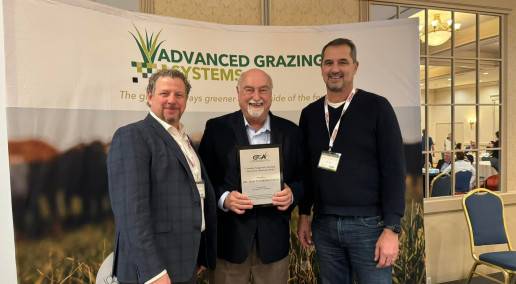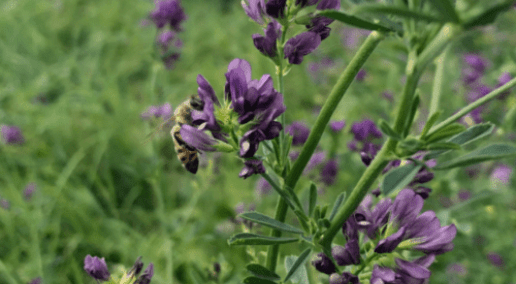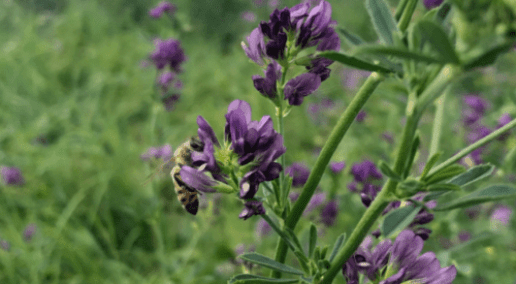Dr. Dan Undersander, a forage specialist and professor emeritus from the University of Wisconsin, presented at the CFGA’s 14th annual conference, Forage Resilience in a Changing Landscape: Manage risk. Overcome challenges. Discover opportunities. on Nov. 29, 2023. His presentation focused on the impacts of maintaining perennial forages, legumes in particular, in rotation to contribute to sustainability.
Dan told attendees as farmers become more sustainable, they become more independent such as by reducing off-farm purchases, while also improving environmental stewardship and quality of life for farm families and communities. Synthetic fertilizers commonly used in the farming industry is a large contributor to greenhouse gas (GHG) emission. By discontinuing the use of synthetic fertilizers by switching to legumes, farmers can offset their nitrogen needs while also saving money.
A study conducted by Jeff Coulter, Michael Russelle, Craig Sheaffer and Dan Kaiser revealed that yields of corn silage and grain following the plantation of alfalfa were unaffected by the nitrogen fertilizer used (zero to 160 pounds of nitrogen per acre). This indicates that farmers can plow down alfalfa fields and plant corn without the need of any synthetic fertilizer.
Similar reductions of nitrogen fertilizer costs were observed when red clover was planted before corn, with N fertilizer replacements being between 70 pounds of nitrogen per acre in Ontario and 140 pounds of nitrogen per acre in Pennsylvania. Another benefit to farmers using red clover is that the nitrogen released from spring-killed clover tends to coincide with the time corn needs nitrogen the most.
Tallying all the fuel-using activities to produce an acre of corn (including discing, fertilizing, planting, harvesting, drying, trucking, etc.) the fuel total equaled 42.5 gallon per acre. By taking out the nitrogen fertilizer and using legume credits instead, the fuel total dropped to 21.9 gallon per acre, a 49 per cent savings in both GHG emissions and cost.
But what makes legumes so special? Legumes are not only a hay crop, but a nitrogen source. By replacing nitrogen fertilizer with legumes, farmers save $97 per acre acre ($217 per hectare) for corn and $67 per acre ($148 per hectare) for wheat. Legumes also have a strong rotational benefit for crop yield. Corn planted after alfalfa yield 20 per cent more crops than corn planted after corn, which allows an additional income of $1,032 per hectare from yield increase, while also providing further savings by not using nitrogen fertilizer.
By using legumes, farmers also increase soil organic carbon (SOC) accumulation. Under perennial systems, such as pastures, SOC accumulation is greatest in the first and second year of the stand, while annual cropping systems lead to a lower SOC accumulation. By using an alfalfa-corn rotation, the nitrogen supplied by legumes increases decomposition from crop residues - which contain more carbon than nitrogen - into SOC, thus building soil carbon.
The use of legumes is also associated with soil health, resilience, water holding capacity and drought tolerance. Several legumes have tap roots that reach six to eight feet deep and have half-inch diameters that open pathways in soil that allow the promotion of water and air movement through the soil. Legume roots also produce the protein gromulin, which serves as a glue that builds larger soil aggregates, increasing pore space. In addition, legumes provide a permanent cover for highly erodible or sensitive land areas.
In summary, by adding legumes into crop rotations, farmers allow for high quality forage and nitrogen fertilizer and yield increases for the following crop. Agronomist recommendations instructing farmers to get the maximum legume benefits (nitrogen credits, yield increases, SOC increases), to use coated seed with fungicide and to have the first year with a cover crop for alfalfa (or to interseed with red clover), allude to the value of two-year-long legume stands. By using legumes appropriately, we can increase farmer independence by reducing purchased off-farm inputs.
Access to the recordings of the 2023 conference proceedings will be available for purchase soon. If you would like to know when they become available email [email protected]
Additional Information
Back to Most Recent



Leave a Comment